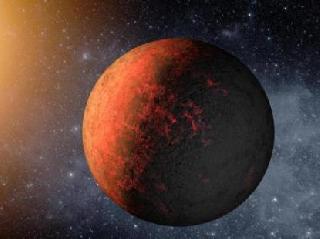
This artist's conception illustrates Kepler-20e. A NASA photo
MOFFET FIELD, CALIFORNIA (BNS): Discovery of two Earth-size planets orbiting a Sun-like star outside our Solar System has reinvigorated scientists' belief that life could exist elsewhere in the Universe.
The planets, spotted by NASA's Kepler spacecraft and named Kepler-20e and Kepler-20f, however, are too close to their host star to be in the so-called habitable zone where liquid water could exist on their surface.
But they are the smallest exoplanets ever confirmed around a star like our Sun, NASA said.
"This discovery demonstrates for the first time that Earth-size planets exist around other stars, and that we are able to detect them," said Francois Fressin of the Harvard-Smithsonian Center for Astrophysics and lead author of the new study published in the journal Nature.
One of the planets is slightly smaller than Venus and another is little larger than Earth. Both planets, believed to be rocky, reside in a five-planet system called Kepler-20, nearly 1,000 light-years away in the constellation Lyra.
While Kepler-20e orbits its parent star every 6.1 days, Kepler-20f rotates around the star in every 19.6 days.
Such short orbital periods mean very hot, inhospitable worlds. The scientists calculate the surface temperature of Kepler-20e to be over 760 degree Celsius and that of Kepler-20f about 425 degree Celsius.
The Kepler20 system, of which the new-found pair of stars is a part, includes three other planets that are larger than Earth but smaller than Neptune. Kepler-20b, the closest planet, Kepler-20c, the third planet, and Kepler-20d, the fifth planet, orbit their star every 3.7, 10.9 and 77.6 days.
All five planets have orbits lying roughly within Mercury's orbit in our solar system. The host star belongs to the same G-type class as our sun, although it is slightly smaller and cooler.
The planetary scientists find the system having an unexpected arrangement when compared to our Solar System.
Unlike the Solar System, where small, rocky worlds orbit close to the Sun and large, gaseous worlds orbit farther out, the planets in Kepler-20 are organised in alternating size: large, small, large, small and large.
"The Kepler data are showing us some planetary systems have arrangements of planets very different from that seen in our solar system.
"The analysis of Kepler data continue to reveal new insights about the diversity of planets and planetary systems within our galaxy," said Jack Lissauer, planetary scientist and Kepler science team member at NASA's Ames Research Center in California.
The Kepler spacecraft, earlier this month, had detected another planet, Kepler-22b, lying in the habitable zone of its host star that strengthened astronomers' belief that exoplanets could hold life.
The new discovery has bolstered planet hunters' efforts in spotting life-bearing planet in the cosmos.
"In the cosmic game of hide and seek, finding planets with just the right size and just the right temperature seems only a matter of time," said Natalie Batalha, Kepler deputy science team lead and professor of astronomy and physics at San Jose State University.
 Previous Article
Previous Article Next Article
Next Article













The Indian Air Force, in its flight trials evaluation report submitted before the Defence Ministry l..
view articleAn insight into the Medium Multi-Role Combat Aircraft competition...
view articleSky enthusiasts can now spot the International Space Station (ISS) commanded by Indian-American astr..
view article